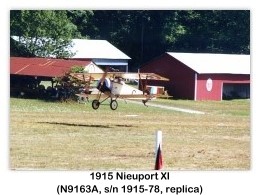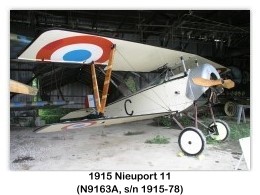
| ||||
|---|---|---|---|---|
 |
 |
 |
 |
 |



























| ||||
|---|---|---|---|---|
 |
 |
 |
 |
 |


























Nieuport 11 Bébé
WWI single-engine single-seat biplane fighter, France
Archive Photos
1915 Nieuport XI Bébé (N9163A, s/n 1915-78) on display (7/18/1999) at the Old Rhinebeck Aerodrome, Rhinebeck, New York (Photos by John Shupek)






1915 Nieuport XI Bébé (N9163A, s/n 1915-78) on display (9/18/2003) at the Old Rhinebeck Aerodrome, Rhinebeck, New York (Photos by John Shupek)

Overview
The Nieuport XI, often nicknamed the Bébé, was a French World War I single seat fighter aircraft, designed by Gustave Delage. It is famous as one of the aircraft that ended the ’Fokker Scourge’ in 1916. The Nieuport XI was basically a smaller, neater version of the Nieuport X — designed specifically as a single-seat fighter. Like the Nieuport X the Nieuport XI was a sesquiplane, a biplane with a full-sized top wing with two spars, and a lower wing of much narrower chord and just one spar, and allegedly intended to have been made to function as the ailerons for the design, by pivoting around the single spar. This was not proceeded with, and conventional ailerons were placed on the upper wing instead during the initial design phase. A "Vee" interplane strut joined the monospar lower wing with the broader upper wing on each side. The main drawback of this particular layout is that unless it is very strongly built, the narrow lower wing is prone to twist and bend under stress. This was a problem with all the "Vee-Strut" Nieuports, as well as the German Albatros D.III, Albatros D.V and Albatros D.Va, which adopted a generally similar wing design.
Nieuport XI’s were supplied to the Aéronautique Militaire, the Royal Naval Air Service, the Dutch air service, Belgium, Russia and Italy. 646 were license produced by the Italian Macchi company. Although its own operational career was short, it was the first in a line of single seat "Vee-Strut" Nieuport fighters — the most important being the Nieuport 17, Nieuport 24bis and Nieuport 27.
Nieuport 16
In 1916 an improved version appeared as the Nieuport 16 which was a Nieuport XI airframe powered by the 110 hp (92 kW) Le Rhône 9J rotary engine. Visible differences included a larger aperture in front of the "horse shoe" cowling and, at least in some cases, a pilot headrest fairing. Later versions had a deck-mounted synchronized Vickers gun, but in this configuration the combined effect of the heavier Le Rhône 9J engine and the heavier Vickers gun compromised maneuverability and made the craft decidedly nose-heavy. The next variant, the slightly larger Nieuport 17 C1, was designed from the outset for the heavier engine, and remedied the Nieuport 16’s c.g. problems, as well as providing an improved performance.
Operational History
The type reached the French front in January 1916, and 90 were in service within the month. This small, lightly loaded sesquiplane outclassed the Fokker Eindecker in practically every respect. Among other features it had ailerons for lateral control rather than the obsolete wing warping of the Fokker, and its elevator was attached to a conventional tail plane as opposed to balanced "Morane type" elevators, making it much easier to fly accurately. The Fokker’s success had largely been due to its synchronized machine gun which fired forward through the arc of its propeller. At the time, the Allies did not possess a similar system, and the Nieuport XI’s Lewis or Hotchkiss machine gun, both designs having open bolt firing cycles unsuitable for synchronization, was mounted on the top wing to fire over the propeller, achieving similar results. There were however problems with clearing gun jams and replacing ammunition drums in flight, which were eventually solved in British service with the invention of the Foster mounting, and in French service by the adoption of the Alkan synchronization gear, which was applied to Nieuport fighters from the Nieuport 17 onwards.
During the course of the Battle of Verdun in February 1916, the Nieuport XI inflicted heavy losses on the enemy, forcing a radical change in German tactics. Some Nieuport XI’s were modified in service to fire Le Prieur rockets from the struts. These weapons were intended for attacks on observation balloons and airships. By March 1916 the Bébé was being replaced by the improved Nieuport 17. This type was in turn replaced by SPAD S.VII in most French squadrons early in 1917, and by the Royal Aircraft Factory S.E.5a in British squadrons later in the year. Thereafter the Nieuport single seat types were widely used as trainers.
Variants
Operators
Nieuport XI Bébé Specifications
General Characteristics
Performance
Armament
References